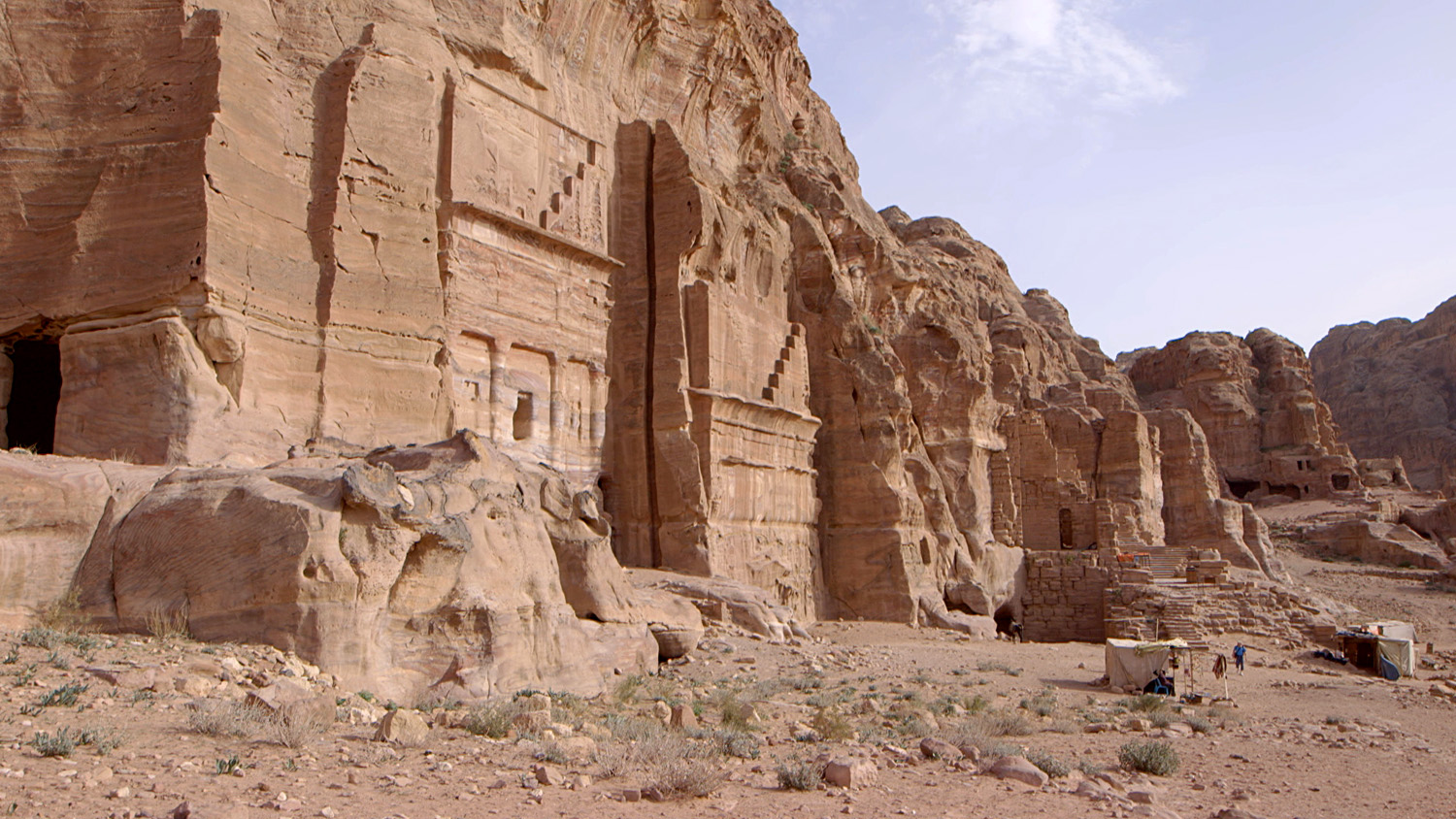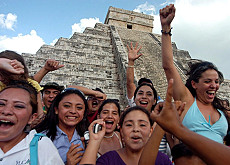The wonder in the desert

Exactly 200 years ago, the remarkable cliff city of Petra in present-day Jordan was rediscovered by Basel native Johann Ludwig Burckhardt. To mark the occasion, swissinfo.ch paid a visit to Swiss archaeologists working in Petra.
The treasury, treasure house, the castle of the Pharaoh, or simply: the gate. The monumental edifice, constructed at the end of a long, narrow canyon, casts a spell over everyone who visits the ancient city of Petra. Even today, no one knows why, or in whose honour, this door was hewn out of the cliff. Thus the many names.
“The Bedouins who settled here several hundred years ago couldn’t imagine how people who lived in tents, like them, could build something so magnificent out of stone,“ says Swiss Ueli Bellwald, who has been working in Petra for 20 years. “The nearest major construction are the pyramids of Giza near Cairo. The Bedouins therefore assumed that this building was also created by the pharaohs, and that they had hidden treasure here.”
City of the Nabataeans
So far, no treasure has been discovered. The tourists come anyway – a million of them in 2010.
Petra is considered one of the largest and most fascinating archaeological cities in the world. Its architects, the Nabataeans, were rich. They traded in the luxury goods of antiquity: incense and myrrh from the Arabian peninsula, spices from India, silk from China. Fortunately for them, Petra was a hub of transportation, passed by all caravans before they transported their valuable goods to the Mediterranean port of Gaza or further in the direction of Europe.
The gate described above is just one of thousands of chambers hewn out of the cliffs. Not all are as artfully decorated or as big as the treasury, but the ancient city holds an almost mystical fascination for visitors. That also has to do with the fact that Petra is car-free – visitors are transported through the city by camels, mules, or horses. In order to truly see Petra, travellers must set aside several days.
Sheikh Ibrahim
Johann Ludwig Burckhardt, who was from Basel, is considered the founder of local tourism in Petra. He is almost a national hero in Jordan, according to Bellwald.
Burckhardt studied in Leipzig and Göttingen before heading to England in 1806. At Cambridge he learned Arabian and took courses in medicine, archaeology and minerology. The African Association, a sort of think tank comprising influential men of the British upper class, gave him a mandate to explore the headwaters of the Niger.
To prepare for his long journey, Burckhardt lived for almost three years in the Syrian city of Aleppo. He claimed to be an Indian businessman, called himself Sheikh Ibrahim, studied the Koran and, among other texts, translated Daniel Defoe’s adventure novel Robinson Crusoe into Arabic.
On the way to Petra
In 1812, Burckhardt set off in the direction of Palestine. As he travelled east of the Dead Sea, there were increasing signs of a large, ancient city in the area. “I was especially eager to visit Wadi Musa, the valley of Moses, whose historical sites locals had spoken of with great admiration,” Burckhardt wrote in his journal.
But the Bedouins greeted him with mistrust. Foreigners, they believed, were searching for treasure to steal. So, Burckhardt used a ruse in order to get to Petra. He hired a guide to take him to the grave of Aaron, brother of Moses, where he planned, according to Muslim tradition, to honour Aaron by sacrificing a goat. The trick worked, and Burckhardt became the first European in almost 1000 years for whom the road to Petra was opened.
Water in the desert
Today’s visitors to Petra travel in more comfort. For more than 200 kilometres, the road leads straight through the desert. Then, gradually, the scenery changes. Single stands of trees, terraced fields with olive trees, even flowers become visible. Wadi Musa, at the end of which Petra lies, is a fertile valley. Most of the rain falls in winter and spring. The difficulty lies in collecting and channeling the rainwater.
“It’s similar to the situation we have in the mountains,“ explains Bellwald. “When it rains, the water primarily falls on rock. It can’t seep down anywhere and within minutes it has built up into a huge wave that destroys everything that stands in its way. In order to deal with this situation, the Nabataeans built dams. A unique system in antiquity.”
With the help of local workers, Bellwald has reconstructed the irrigation system of the Nabataeans. The most noticeable feature is the canals with overflow basins which can be seen on either side of the canyon. The numerous dams, large and small, lie in the craggy side valleys and are off limits to tourists.
Swiss in Petra
Bellwald is not the only Swiss in Petra. The Nabataean villa Ez Zantur was excavated by researchers from Basel University, and parts of its ornamental inner rooms were reconstructed. And on one of the highest hills ringing Petra, the Basler Stephan Schmid and his students from Humboldt University in Berlin are hard at work. In 2004, Schmid discovered foundations which have since taken on the form of a palace with baths in the style of the Greeks and Romans.
A palace on a mountain where there’s no wood or water?
“Yes,” says Schmid. “Every branch that was burned had to be carried up from far away. Kind of mad. The person who lived here must have had the power, the means and the influence to ensure that this building was built and maintained.” He theorizes that the palace was the Nabataeans‘ answer to the rock fortress Masada in present-day Israel.
The first Swiss visitor, Johann Ludwig Burckhardt, never lived to learn that the city he discovered was actually the ancient city of Petra. In 1817, at the age of 33, he died in Cairo of an intestinal disease. His travelogues didn’t appear until after his death, and when they did, it created quite a storm. “Everyone wanted to travel to the Orient,” recounts Bellwald. “And, like Burckhardt, they dressed up as Bedouins.”
On the occasion of the 200th anniversary of the rediscovery of Petra, the Basel Antiquities Museum presents the findings of the newest archaeological research in Petra, with significant participation by Swiss researchers. The exhibition begins October 23.
Around 150 first-class original pieces from Jordan, as well as computer animation models, show where the Nabataeans came from, how they wrote, and which gods they worshipped.
Visitors will learn how the Nabataeans were able to build and provide water for a gigantic city in the middle of the desert.

In compliance with the JTI standards
More: SWI swissinfo.ch certified by the Journalism Trust Initiative

You can find an overview of ongoing debates with our journalists here. Please join us!
If you want to start a conversation about a topic raised in this article or want to report factual errors, email us at english@swissinfo.ch.